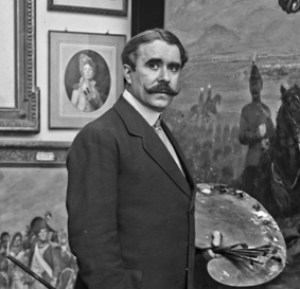21, rue de Saillé
44350 GUÉRANDE
Georges Scott ( - )

Born in the 1870s in Manchester to an Alsatian father who designed fabrics, Frank Scheidecker made a career in Mulhouse in the arts and crafts. But his passion remained painting and watercolours, which his father did not give him the opportunity to study at the Beaux-Arts, so as not to lose his talent within the family business. It is therefore with his brother Paul, who had this chance, that he refined his pictorial technique.
Creativity was always the driving force behind Frank Scheidecker's work, first in his early years as a draughtsman for printed canvases, an activity he carried out from a young age with his father and until his death in the family business with one of his brothers. Then at the end of the 19th century, driven by the desire to renovate the applied arts, and after having tried his hand at pyrography, wood painting and furniture design, he finally found his way into copper and silver chasing. His field extends to all the metal appliqués that complete a piece of joinery: door plates, lock escutcheons, door handles. For the table, he creates trays, coffee sets, knife holders, bread baskets, even silverware. He designs hanging baskets and lampshades, clocks, combs, belt buckles...
He is a complete artist, as shown by this painting of the great wash-house in Vannes. He seems to have been very inspired by the washerwomen, a subject often found in his Breton paintings.